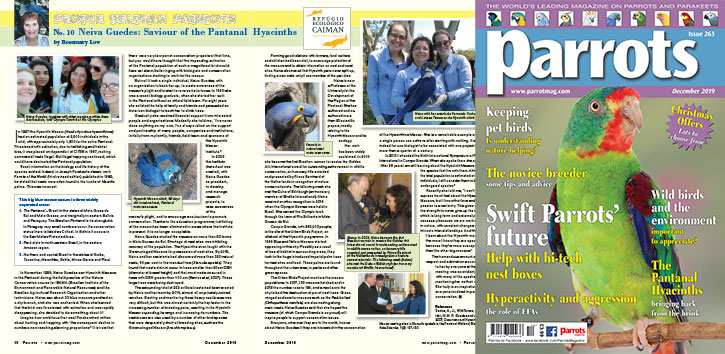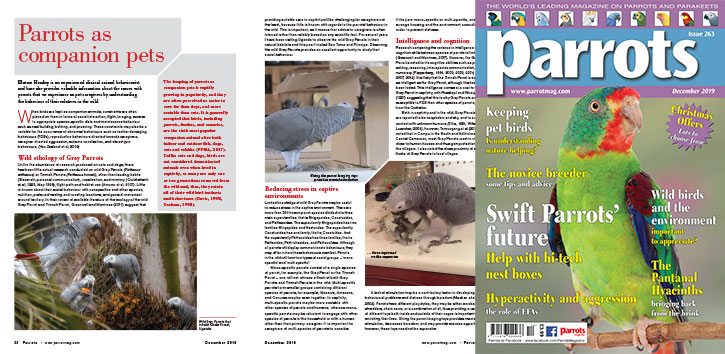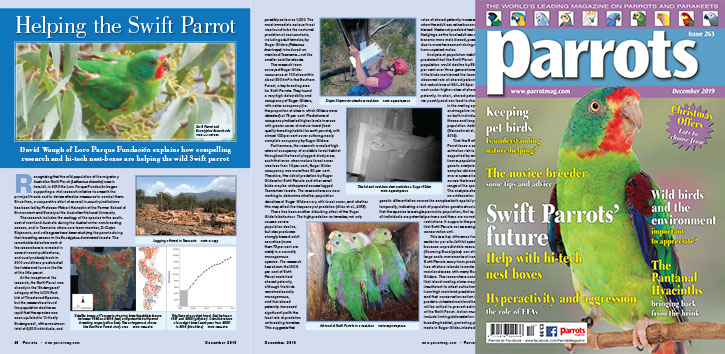
Complete Psittacine by Eb Cravens
I have been questioned by many beginning bird keepers over the years with queries about simple avicultural subjects the answers to which are readily available in a wide circulation of books and magazines about psittacines. Things like, “Can you tell me how to get my pair of cockatiels to breed?” Or, “What should I feed my Green-cheeked Conure?” I tend to patiently reply to such requests, but it does make me wonder about the depth of commitment the parrot or parakeet owner has developed.
The avicultural world is replete with amateur bird breeders who basically ‘wing it’ when it comes to taking care of their birds. Some believe it is easy work to breed psittacines while some are well intentioned, but rather lazy, and some have dollar signs in their eyes. In a gentle manner, my advice to such hobbyists is, “Study and work harder so you know what you are doing or else give up the dream!”
Buy Now!

People Helping Parrots by Rosemary Low
In 1987 the Hyacinth Macaw (Anodorhynchus hyacinthinus) had an estimated population of 2,500 individuals in the wild, with approximately only 1,500 for the entire Pantanal. Threatened with extinction, due to trafficking and habitat loss, it was placed on Appendix I of CITES in 1987, making commercial trade illegal. But illegal trapping continued, which could have decimated the Pantanal population.
Scant information on the biology and life history of the species existed. Indeed, in Joseph Forshaw’s classic work Parrots of the World (third revised edition) published in 1989, he stated that nests were often found in the trunks of Mauritia palms. This was incorrect.
Buy Now!

By Elaine Henley
The keeping of parrots as companion pets is rapidly growing in popularity, and they are often perceived as easier to care for than dogs, and more sociable than cats. It is generally accepted that birds, including parrots, finches, and canaries, are the sixth most popular companion animal after both indoor and outdoor fish, dogs, cats and rabbits (PFMA, 2017). Unlike cats and dogs, birds are not considered domesticated animals even when bred in captivity, as many are only one or two generations removed from the wild and, thus, they retain all of their wild bird instincts and behaviours (Davis, 1998, Graham, 1998).
When birds are kept as companion animals, constraints are often placed on them in terms of social interaction, flight, foraging, access to appropriate species-specific diets and maintenance behaviour such as nest building, bathing, and preening. These constraints may also be a variable for the occurrence of abnormal behaviours such as feather damaging behaviours (FDBs), reproductive behaviours directed towards caregivers, caregiver directed aggression, extreme vocalisation, and stereotypic behaviours, (Van Zeeland et al, 2009).
Buy Now!

By David Waugh
Recognising that the wild population of the migratory Australian Swift Parrot (Lathamus discolor) was in free-fall, in 2010 the Loro Parque Fundación began supporting a vital research initiative to unearth the principal threats and to devise effective measures to combat them. Since then, a cooperative effort of several in-country institutions has been led by Professor Robert Heinsohn of the Fenner School of Environment and Society at the Australian National University.
The research includes the ecology of the species in the south-east of mainland Australia during the Austral winter non-breeding season, and in Tasmania where core team member, Dr Dejan Stojanovic, and colleagues have been studying the parrots during their breeding season in the Eucalyptus-dominated forests. The remarkable detective work of the researchers is revealed in several recent publications, and surely nobody back in 2010 could have predicted all the twists and turns in the life of this little parrot.
At the inception of the research, the Swift Parrot was already in the ‘Endangered’ category of the IUCN Red List of Threatened Species, but the researchers found the population decline so rapid that the species was soon up-listed to ‘Critically Endangered’, with a maximum total of 2,500 individuals, and possibly as few as 1,000. The most immediate serious threat was found to be the nocturnal predation of nest-contents, including adult females, by Sugar Gliders (Petaurus breviceps) introduced on mainland Tasmania – not the smaller satellite islands.
Buy Now!




